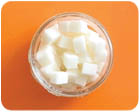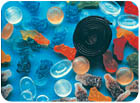
In general, the sweetness potency of most intense sweeteners depends on their concentration in solution; the higher the concentration of the sweetener, the lower its potency. The sweetener's strength also depends on the temperature at which the solution is evaluated; the lower the temperature, the lower the potency of the sweeteners. These comparisons usually are made with solutions of sucrose, using expert tasters who have high sweetness acuity and who are trained in taste profiling techniques.

Potency Factors
The potency of an intense sweetener is an important basic characteristic, due to its impact on a variety of issues including relative cost and amounts consumed (the latter impacting safety considerations). Accordingly, most publications provide a general potency value for an intense sweetener. In reality, as previously stated, the potency is affected by many factors. This point is illustrated below by examining some available data on aspartame and other sweeteners.* Aspartame commonly is described in literature as being about 200 times sweeter than sucrose. In fact, as mentioned before, like other intense sweeteners, the sweetness potency of aspartame is inversely related to its concentration; the lower the concentration, the higher its potency. For example, in a typical concentration used in tabletop applications (4.3% sucrose), aspartame is about 200 times sweeter than sucrose. In concentrations used in beverages (10% sucrose), the potency is about 130 times sucrose at a solution temperature of 72°F. At a cold temperature of 46°F, aspartame is 160 times sucrose for a concentration equivalent to 4% sucrose, and 100 times sucrose for a concentration equivalent to 12% solution. These data clearly indicate the potency of aspartame is variable and needs to be adjusted for the specific application in which it is being used.
* Published reports discussing the sweetness potency of sucralose generally refer to this intense sweetener as being 600 times sweeter than sucrose. Here again, data suggest the sweetness potency is inversely related to its concentration. At a concentration equivalent to 2% sucrose in an aqueous medium at room temperature, the potency is about 700 times sucrose; at 4% sucrose equivalency, it is about 600 times sucrose; and at 9% sucrose equivalency, it is 500 times sucrose.
* The same relationship between concentration and sweetness potency is observed in saccharin. Saccharin usually is referred to as being 300 times sweeter than sugar where, in fact, its sweetness potency is 360 times sucrose at a concentration equivalent to 5% sucrose solution, and 330 times sucrose at a concentration equivalent to 10% sucrose solution. Acesulfame-K shows a similar pattern and varies between 200 and 100 times sucrose in the range of equivalent sucrose concentrations of 2% and 6% sucrose solution.
The potency of intense sweeteners is not only dependent on concentrations and on temperature as mentioned above, but is highly dependent on the medium in which it is added. Factors such as acidity, pH, flavor level and character, viscosity and presence of other sweeteners (both intense and nutritive sweeteners) may have a major impact on the potency of the sweetener as well as other sensory attributes. Studies with aspartame have shown it has a sweetness potency of 180 times sucrose in cold soft drinks. In cold still beverages, the sweetness potency is about 150 times sucrose; in cold gelatin desserts, the potency is between 160 and 172 times sucrose.
Applications Matter
Other sweetness sensory attributes are affected by the type of food to which the intense sweetener is added. Experiments conducted by the authors of this article indicate that products sweetened with saccharin have a quick sweetness onset but a lingering metallic or bitter taste when used in high concentrations. At low concentrations (concentrations equivalent to 4% sucrose or lower), the initial quick sweetness onset is retained, but there is a significant reduction in the level of aftertaste. Thus, when used in combination with other sweeteners at low concentration, saccharin is an excellent sweetener because it provides the quick front sweetness onset other sweeteners do not have. Miller (Sucralose in Alternative Sweeteners, second edition), describes the temporal sweetness characteristics of several sweeteners. The data indicate that (under these specific test conditions) the time to reach maximum sweetness was 3.1 seconds for saccharin versus 4.1 for sucrose and 5 for sucralose. These data are presented graphically in the charts “Intense Sweeteners: Maximizing Sweetness” and “Intense Sweeteners: Duration Time.”In order to illustrate the impact of the flavor and medium on the taste perception of cola beverages sweetened with intense sweeteners, the authors prepared in their laboratory samples of cola soft drinks sweetened with sugar, aspartame, aspartame/saccharin blend, sucralose and sucralose/acesulfame-K blend. The beverages were evaluated for sweetness intensity, sweet aftertaste and bitterness. The results are summarized in the chart “Sensory Profile of Cola Soft Drinks with Various Sweeteners” (see this chart in the online edition of this article at www.PreparedFoods.com) and show that the cola sweetened with sucralose alone was the least sweet, and both colas with sucralose alone and with acesulfame-k with sucralose had the highest sweetness aftertaste intensity score.
| Sweetener | Sweetener Concentration (mg/100ml) | Sweetness Intensity* | Sweet Aftertaste** | Other Comments | |
|---|---|---|---|---|---|
| Sugar | 1,125 | 5.5 | 1.5 | Clean taste | |
| Aspartame | 52 | 7.0 | 3.6 | Delayed sweetness | |
| Aspartame/saccharin | 16.7/16.7 | 6.0 | 2.0 | Sweet aftertaste | |
| Sucralose | 17.5 | 4.1 | 4.2 | Bite of cola flavor | |
| Acesulfame-K/sucralose | 12.5/16.7 | 5.5 | 4.3 | Reduced cola flavor |
** 0=none, 8=very strong
Source: ABIC International Consultants Inc./PF
It is interesting to note that the sweetness intensity of the sucralose-sweetened cola was the lowest, even though the expected sweetness based on a potency value of 600 times sucrose suggests the sweetness intensity should be similar to the sugar-sweetened cola. It is clear that, in this application, the sweetness potency of sucralose is significantly less than 600 times sucrose.
In other experiments conducted in the same laboratory, the authors evaluated the use of nutritive sweeteners and aspartame or sucralose on the sweetness intensity of fruit-flavored beverages. The beverages contained 5% fructose and either 0.014% aspartame or 0.005% sucralose. Assuming a potency of 200 for aspartame and 600 for sucralose, this level of 0.05% sucralose is somewhat higher than the calculated values on the basis of these sweetness potencies. The taste panel, however, found the sweetness intensity of the aspartame beverage significantly higher than the sweetness intensity of the sucralose-containing beverage (a score of 4.6 for aspartame versus 3.2 for sucralose on a scale in which 0=none and 8=very sweet). The panel rated the flavor intensity of the beverage containing aspartame as higher than the beverage with sucralose.
In conclusion, the experiments indicate that sweetness and flavor information available about intense sweeteners is very useful, but food scientists and formulators need to keep in mind that this data can serve only as a guide. Additional work is needed to optimize the level of the intense sweetener in the specific food product. If more than one intense sweetener is used, the probability of developing a product that is close to the sucrose-sweetened control is much higher. However, additional factors must be considered, including potential synergy between the intense sweeteners that reduces the level of sweetener needed to achieve the desired sweetness intensity.
Website Resources:
www.PreparedFoods.com -- Type “sweeteners” into the LINX searchable database for several articles on the subjectwww.discover.com -- Type “artificial sweeteners” into the search field for many articles on different types of sweeteners
www.eatright.org/cps/rde/xchg/ada/hs.xsl/index.html -- Several articles will appear after typing “artificial sweeteners” in the search field; the first has several useful charts
Sidebar: Sweetener Mobility
“Sucralose has become so popular because it is a more stable product than other non-nutritive sweeteners,” says Kevin Riley, technical director of sweet flavor applications at a global flavor company. Nevertheless, in applications like ice cream, sucralose cannot be used as a 1:1 replacement of sucrose because it does not provide bulking. Viscosity has an impact on the perception of sweetness. It is more difficult to perceive sweetness in a high-viscosity product, whether it is a baked good, candy or beverage.One solution is to increase the sweetness in high-viscosity products, says Riley. If that does not work, the product developer may add sweetness-modulating flavor systems that contain unique molecules.
In addition, switching from sucrose or a high-fructose corn syrup to a high-intensity sweetener (HIS) can cause the product to lose other characteristics that sugar will impart, such as browning and viscosity. As a result, it is important to find ingredients that will build that body back into the product.
Mouthfeel enhancers contribute body lost with HIS. Stabilizers also round out the aftertaste. “Unfortunately, by adding them, you are changing the overall product design to compensate for the deficiency in the sweetener systems,” says Riley. “Although that can be done, it is like letting the tail wag the dog.”
--Marcia A. Wade, Technical Editor